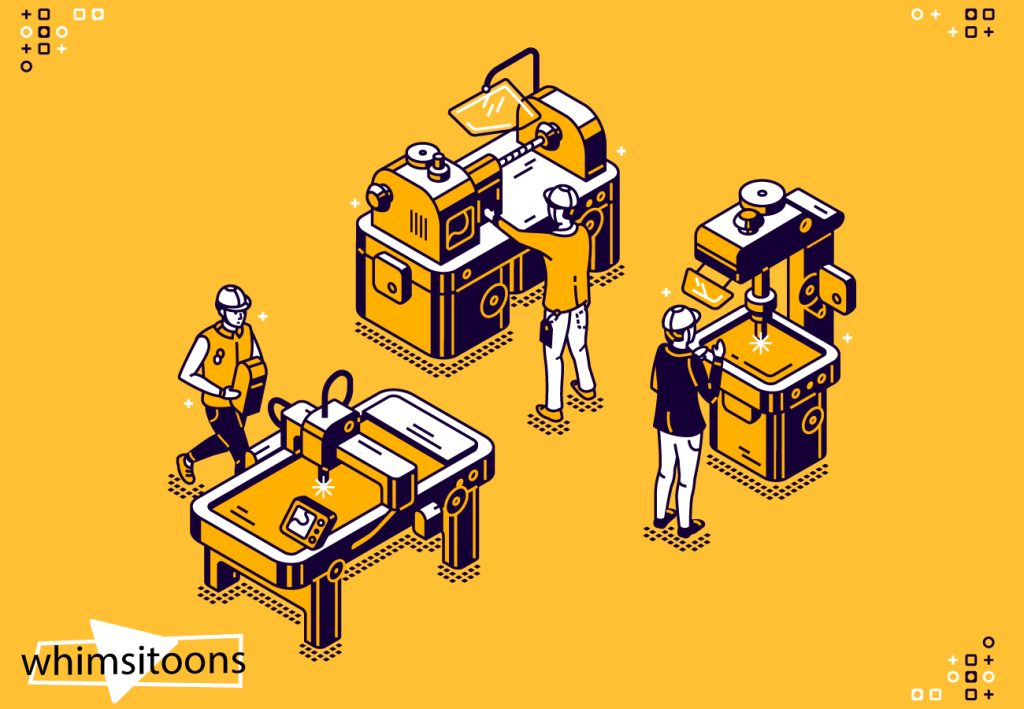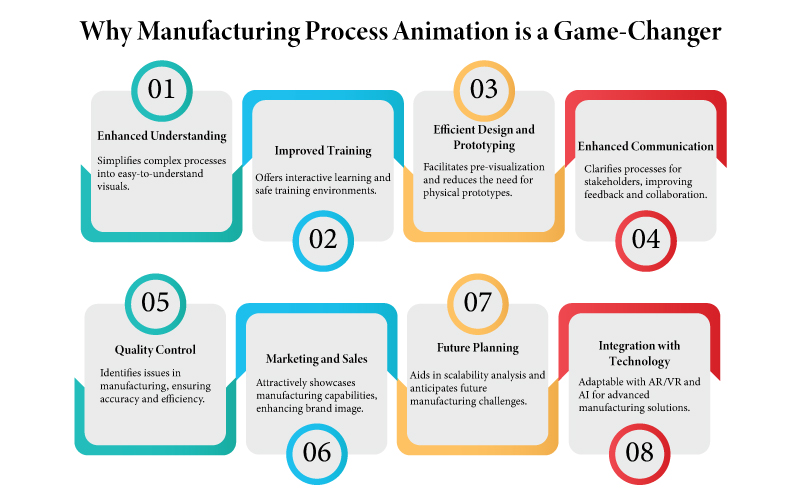How Manufacturing Process Animations Are Changing the Industry

In manufacturing and industry, effective communication is key. This is where Manufacturing Process Animation steps in, a powerful tool transforming how companies conceptualize, communicate, and educate about their manufacturing processes. With clear, detailed animations, complex processes are simplified, enhancing understanding for everyone from stakeholders to the shop floor workers.

Enhanced Clarity and Understanding
Manufacturing involves intricate processes, often difficult to explain through words or static images. Animation brings these processes to life, making them easier to understand and visualize. This clarity is crucial for training, presentations, and marketing.
Time and Cost Efficiency
Creating a physical model or prototype can be time-consuming and costly. Animation side steps these issues, offering a quicker and more cost-effective way to demonstrate and iterate manufacturing processes.
Improved Safety Training
In manufacturing, safety is paramount. Animated sequences can illustrate safety procedures effectively, highlighting potential risks and the correct way to handle them, thereby reducing workplace accidents.
Marketing and Client Engagement
2D and 3D Animation can be powerful marketing tools. They provide an engaging way to showcase your manufacturing capabilities to potential clients, helping them understand the value and difficulty of your work.
Customization and Flexibility
Unlike static diagrams or models, animations can be easily updated and customized, making them a flexible tool for communicating changes or upgrades in manufacturing processes.
The Process of Creating Manufacturing Process Animations
Step 1: Conceptualization
The first step involves understanding the manufacturing process in detail. This might involve site visits, discussions with engineers, and reviewing process documents.
Step 2: Storyboarding
Once the process is understood, a storyboard is created. This is a series of sketches that outline the animation, ensuring that all key elements of the manufacturing process are included and accurately represented.
Step 3: Modeling and Animation
Using specialized software, the actual animation is created. This involves 3D modeling, texturing, and animating the process in a way that is both accurate and visually appealing.
Step 4: Post-Production
After the animation is complete, post-production work such as adding voice overs, background music, and editing ensures that the final product is polished and professional.
The Integration of VR and AR in Manufacturing Process Animation
The future of manufacturing process animation lies in the integration of Virtual Reality (VR) and Augmented Reality (AR). This technology takes visualization to the next level, offering immersive experiences that can revolutionize training, design, and client engagement.
The Role of Animation in Industry 4.0
Industry 4.0 is all about smart technology and interconnected systems. Manufacturing process animation plays a pivotal role here by helping visualize and understand these complex systems, making them an integral part of the Industry 4.0 revolution.
Future Trends in Manufacturing Animation
Manufacturing process animation in USA continues to evolve, influenced by technological advancements and changing industry needs. Understanding these future trends is essential for staying ahead in the competitive landscape of industrial visualization. Here’s what we can anticipate:
- AI-Driven Animations: Artificial Intelligence (AI) is poised to revolutionize manufacturing animations. AI algorithms can automate complex animation processes, create more realistic and dynamic visualizations, and even predict and illustrate potential manufacturing issues before they occur. This predictive capability can be a game-changer in planning and optimizing manufacturing processes.
- Increased Use of Virtual Reality (VR) and Augmented Reality (AR): VR and AR technologies are becoming more sophisticated and accessible. In the future, we can expect an even greater integration of these technologies in manufacturing animation. This integration will provide immersive experiences that can be used for training, showcasing intricate manufacturing processes to clients, or testing new manufacturing setups in a virtual environment before physical implementation.
- Cloud-Based Animation Solutions: The future of manufacturing animation will likely be dominated by cloud-based solutions. These platforms offer the advantage of scalability, remote collaboration, and the ability to constantly update and refine animations without the need for intensive local computing power.
- Customization and Personalization: As manufacturing processes become more specialized, the demand for highly customized and personalized animations will grow. Tailor-made animations that cater specifically to a company’s unique processes, machinery, and products will be more effective in training, sales, and marketing.
- Integration with IoT and Smart Factory Concepts: As the Internet of Things (IoT) and smart factory concepts become more prevalent in manufacturing, animations will need to evolve to accurately represent these interconnected systems. This means animations will not only depict mechanical processes but also the flow of data and digital interactions within the manufacturing ecosystem.
- Sustainability and Green Manufacturing: With a growing emphasis on sustainability, future manufacturing animations may also focus on illustrating eco-friendly practices and green manufacturing processes. This will not only help in internal process optimization but also in demonstrating a company’s commitment to sustainability to customers and stakeholders.
- Enhanced Interactivity: Future animations are likely to be more interactive, allowing users to explore different aspects of the manufacturing process in a non-linear fashion. This can be particularly useful in training scenarios, where individuals can learn at their own pace and focus on areas of interest or difficulty.
- Greater Realism and Detail: Advancements in rendering technologies and 3D modeling will enable even greater realism and detail in manufacturing animations. This will allow for more accurate and lifelike representations of manufacturing processes, which can be crucial for technical training and detailed client presentations.
- Analytics-Driven Content: The use of analytics in manufacturing animation will become more prevalent, enabling creators to understand how users interact with their animations. This insight can drive improvements, making animations more effective and engaging over time.
Table: Comparison of Traditional vs Animated Process Communication
| Aspect | Traditional Methods | Animated Process Communication |
| Clarity | Often complex and confusing | High clarity and understanding |
| Cost | Can be expensive | More cost-effective |
| Time Efficiency | Time-consuming | Quicker and more efficient |
| Customization | Limited | Highly customizable |
| Engagement | Low | High engagement and retention |
Bullet Points: Key Takeaways
- Manufacturing process animation provides unparalleled clarity and understanding of complex processes.
- It’s a cost-effective and time-efficient alternative to traditional methods.
- Enhances safety training and reduces workplace accidents.
- Powerful tool for marketing and client engagement.
- Customizable and flexible to suit changing needs.
Conclusion: The Animation Advantage in Manufacturing
The advantage of utilizing animations in the manufacturing sector extends far beyond the visual representation of processes. It is a multifaceted tool that supports training, enhances marketing efforts, demonstrates a commitment to sustainability, and aligns with the strategic objectives of a company. As technology continues to advance, the role of animation in manufacturing is set to become even more integral, solidifying its status as an indispensable asset in the industrial sector.
FAQs
Q 1: How does manufacturing process animation improve training?
It simplifies complex processes, making them easier to understand and remember, leading to more effective and efficient training.
Q 2: Can these animations be used for client presentations?
Absolutely! They are an excellent way to engage potential clients and help them understand the value of your manufacturing processes.
Q 3: Are manufacturing animations customizable?
Yes, one of the biggest advantages is their flexibility and customization potential.
Q 4: How does animation support Industry 4.0?
It aids in visualizing and understanding interconnected, smart systems that are the backbone of Industry 4.0.
Q 5: Whatu2019s the future of manufacturing process animation?
The integration of VR and AR technologies will further enhance the effectiveness and applicability of these animations.










